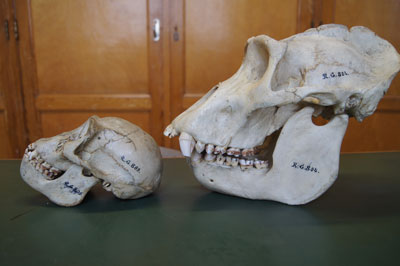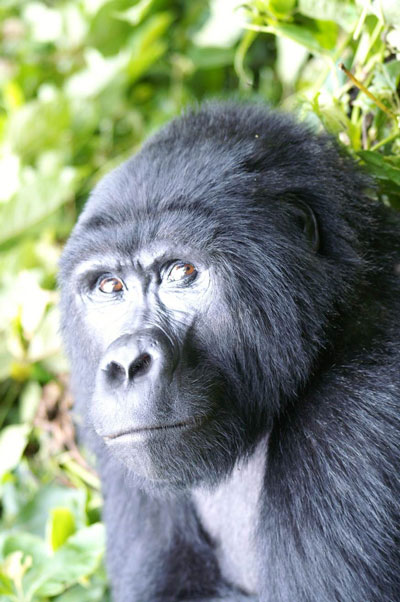Many wild animals have declined in number over the past century as a direct result of human activities. Although such declines can negatively impact long-term species survival, quantifying the consequences of these processes is challenging, as it requires comparing current populations to their pre-decline counterparts. To overcome this obstacle, we studied the genomic profiles of eastern gorillas from museum specimens of over 100 years old and compared them to contemporary genomes.

Figure 1: Some of the gorilla skulls dating from up to 100 years ago that were sampled for the study at the Royal Museum for Central Africa in Tervuren, Belgium.
Using ancient DNA techniques we recovered complete genomes from museum specimens of the well-known mountain gorillas and the little-known Grauer’s gorillas that only occur in the eastern parts of the Democratic Republic of Congo. Whereas mountain gorillas have been the target of dedicated conservation efforts for several decades, which led to steady population increase and even declassification from critically endangered to endangered, the Grauer’s gorillas have lost 80% of their population in the last 20 years alone.
The temporal comparison revealed loss of genetic diversity, increase in levels of inbreeding and increase in the frequency of harmful mutations in Grauer’s but not in mountain gorillas. In particular, genes related to immunity and reproduction were strongly affected, which directly translates into negative consequences for population survival. The differences between mountain and Grauer’s gorillas can be partly explained by their long-term population history. Both subspecies experienced long-term population decline, but whereas the mountain gorilla population remained small for the last few thousand years, Grauer’s gorillas experienced a period of population growth ca. 10,000 years ago. Ironically, this population growth allowed harmful mutations to arise in Grauer’s gorillas through random mutation processes. Now that Grauer’s gorillas experience drastic population size reduction, these harmful mutations appear in a homozygous state, directly affecting the population. In contrast, the constant small population size of mountain gorillas over long periods allowed removal of strongly deleterious mutations from their genomes.

Figure 2: Young mountain gorilla male.
Yet, not all is lost for the Grauer’s gorillas. As seen in mountain gorillas, conservation efforts that allow population recovery and growth can have a significant positive effect on the evolutionary potential of this charismatic species. Our study demonstrates the power of applying temporal comparisons to species of conservation concern. Only by using historical samples could we show the severe consequences of recent human activities and highlight the differences between two closely related gorilla species. We believe that this approach, developed partly due to the support of the HFSP Long-Term Fellowship, will be instrumental in defining conservation priorities in the future.


































